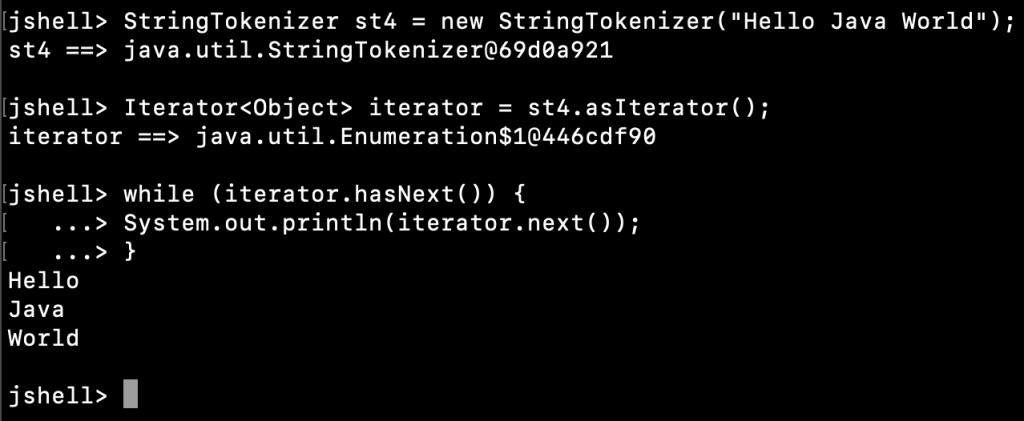Java StringTokenizer class is used to break a string into tokens based on the specified delimiter. This class implements Enumeration interface.
Table of Contents
Java StringTokenizer Constructors
The StringTokenizer class has three constructors.
- StringTokenizer(String str): This creates a string tokenizer instance with the given string and default delimiter characters. The default delimiter characters are the space character ( ), the tab character (\t), the newline character (\n), the carriage-return character (\r), and the form-feed character (\f). The delimiter characters are not part of the token strings.
- StringTokenizer(String str, String delimiter): Creates a string tokenizer instance with the specified string and the delimiter. The delimiter string is not part of the generated tokens.
- StringTokenizer(String str, String delimiter, boolean returnDelims): Similar to the above constructor except that the delimiter string will also be part of the token strings.
StringTokenizer Methods
Some of the useful methods of the StringTokenizer class are:
- hasMoreTokens(): returns true if the string tokenizer has more tokens.
- nextToken(): returns the next token string from the string tokenizer. It throws NoSuchElementException if there are no more tokens in the string tokenizer.
- nextToken(String delimiter): returns the next token string using the given delimiter. After the call, the delimiter string is changed to the default value. If there are no tokens, NoSuchElementException is thrown.
- countTokens(): returns the remaining tokens count in the tokenizer. If it’s called before any call to nextToken() is made, it returns the total numbers of tokens.
- hasMoreElements(), nextElement(): these methods are present to implement Enumeration interface. They call hasMoreTokens() and nextToken() methods internally.
Java StringTokenizer Examples
Let’s look into some real-life usage of the StringTokenizer class.
1. Parsing CSV String to String Tokens
package net.javastring.strings;
import java.util.Iterator;
import java.util.StringTokenizer;
public class JavaStringTokenizer {
public static void main(String[] args) {
// parsing CSV string to tokens
String csv = "Java,Python,Android";
StringTokenizer st = new StringTokenizer(csv, ",");
printTokens(st);
}
private static void printTokens(StringTokenizer st) {
while (st.hasMoreTokens()) {
System.out.println(st.nextToken());
}
}
}
Output:
Java
Python
Android
2. StringTokenizer Default delimiter example
String line = "Welcome to JavaString.net\nLearn\tJava\tProgramming";
StringTokenizer st1 = new StringTokenizer(line);
printTokens(st1);
Output:
Welcome
to
JavaString.net
Learn
Java
Programming
3. Available Tokens Count
StringTokenizer st2 = new StringTokenizer("Hi Hello Yes");
System.out.println(st2.countTokens()); // 3
st2.nextToken();
System.out.println(st2.countTokens()); // 2
4. Returning Delimiters in Tokens
StringTokenizer st3 = new StringTokenizer("Hi|Hello|Yes", "|", true);
System.out.println(st3.countTokens());
printTokens(st3);
Output:
5
Hi
|
Hello
|
Yes
Note that the tokens count is 5 because the delimiter string is also returned as a token.
5. Getting StringTokenizer Tokens as Iterator
Since StringTokenizer implements the Enumeration interface, we can call its asIterator() method to create an iterator from its tokens.
StringTokenizer st4 = new StringTokenizer("Hello Java World");
Iterator<Object> iterator = st4.asIterator();
while (iterator.hasNext()) {
System.out.println(iterator.next());
}
Output:

6. Multiple Delimiters Example
Let’s say we have a string with multiple delimiters. We can use the nextToken(String delimiter) method to handle this scenario.
String data = "1,2#3,4#5,6";
StringTokenizer st5 = new StringTokenizer(data);
int count = 0;
while (st5.hasMoreTokens()) {
if (count % 2 == 0) {
System.out.println(st5.nextToken(",").replace("#", ""));
} else {
System.out.println(st5.nextToken("#").replace(",", ""));
}
count++;
}
Output:
1
2
3
4
5
6
Java StringTokenizer vs split() Method
- StringTokenizer is a legacy class and it’s retained only for backward compatibility. It’s recommended to use split() method to break a string into multiple parts.
- String split() method is more powerful because we can utilize regular expressions for the delimiter. For example, we can use
split(",|#")for the above example which is much simpler and easy to understand. - The code to get all the string tokens from the string tokenizer is a lot when compared to the split() method.
Conclusion
It’s better to know about the StringTokenizer class. But, in most of the real-life scenarios you can get the better code and the same results using the split() method.
